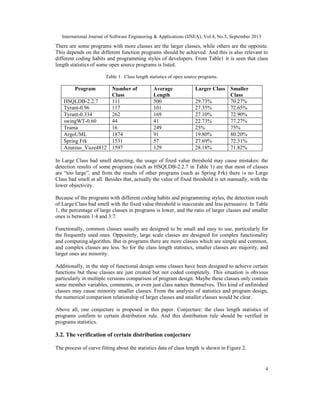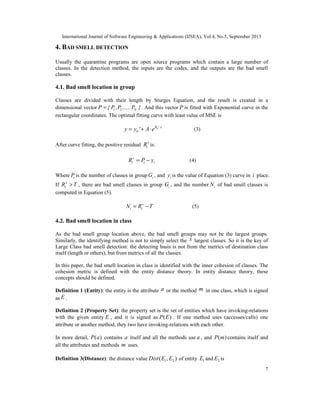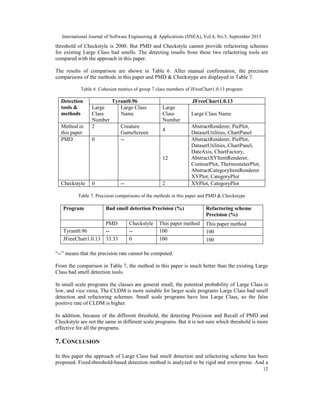This paper presents a method for detecting 'large class' bad smells in software, which are indicative of potential issues within code. The proposed approach employs a class length distribution model and cohesion metrics to identify poorly designed classes, enhancing automatic detection capabilities. Experimental results indicate that this method effectively identifies large classes and provides a basis for refactoring to improve design quality.
![International Journal of Software Engineering & Applications (IJSEA), Vol.4, No.5, September 2013
DOI : 10.5121/ijsea.2013.4501 1
DETECTION AND REFACTORING OF BAD SMELL
CAUSED BY LARGE SCALE
Jiang Dexun1
, Ma Peijun2
, Su Xiaohong3
, Wang Tiantian4
School Of Computer Science and Technology, Harbin Institute of Technology,
Harbin, China
1
negrocanfly@163.com, 2
silverghost192@163.cn
3
Suxh@hit.edu.cn, 4
Wangtt@hit.edu.cn
ABSTRACT
Bad smells are signs of potential problems in code. Detecting bad smells, however, remains time
consuming for software engineers despite proposals on bad smell detection and refactoring tools. Large
Class is a kind of bad smells caused by large scale, and the detection is hard to achieve automatically. In
this paper, a Large Class bad smell detection approach based on class length distribution model and
cohesion metrics is proposed. In programs, the lengths of classes are confirmed according to the certain
distributions. The class length distribution model is generalized to detect programs after grouping.
Meanwhile, cohesion metrics are analyzed for bad smell detection. The bad smell detection experiments of
open source programs show that Large Class bad smell can be detected effectively and accurately with this
approach, and refactoring scheme can be proposed for design quality improvements of programs.
KEYWORDS
Distribution rule; Class length distribution model; Cohesion metrics; Bad smell detection; refactoring
scheme
1. INTRODUCTION
Nowadays, with the development of software programming, the number of software analysis
tools available for detecting bad smells significantly increase. Although these tools are gaining
acceptance in practice, a lack of detection towards some bad smells may decrease the
effectiveness, such as Long Method, Large Class and Long Parameter List [1]. The key of these
bad smells is about the structure and components.
Software programs are composed of components from every level. The component from higher
level is composed of ones from lower level. Characters compose keywords, while keywords,
variables and operators compose statements. The composition level of object-oriented programs
is shown in Figure 1.](https://image.slidesharecdn.com/4513ijsea01-131008005834-phpapp02/85/DETECTION-AND-REFACTORING-OF-BAD-SMELL-CAUSED-BY-LARGE-SCALE-1-320.jpg)
![International Journal of Software Engineering & Applications (IJSEA), Vol.4, No.5, September 2013
2
Figure 1. Composition level of object-oriented programs.
Large Class [1] bad smell is one classical bad smells, meaning a class is too large. The cause of
large classes may be the large number of instance variables or methods. Large Class has long
history, but the detection is always vague. From the definition [1], this bad smell detection should
be achieved by the class length statistics. Usually the class length is measured by the lines of code.
In practice it is difficult to confirm a threshold value for detecting one particular class is too large
or not. So it is also difficult to detect Large Class bad smell particularly in business open source
programs. The fixed threshold value is not fastidious for Large Class bad smell detection.
In this paper a detecting method of Large Class bad smell is proposed based on scale distribution.
The length of all the classes in one program is extracted, and then distribution model of class
scale is built using the length of these classes. In distribution model the groups which are farthest
from the distribution curve is considered to be candidate groups of Large Class bad smell.
Furthermore, the cohesion metrics of the classes in these groups are measured to confirm Large
Class.
The rest of the paper is organized as follows. Section 2 presents a short overview of related work.
In Section 3, the class length distribution model is built to present the distribution rules of class
length. With this model and cohesion metrics presented, the detection method of Large Class bad
smell is proposed in Section 4. Section 5 discusses how to give proper refactoring scheme. And
Section 6 shows the experiment results. The conclusion is provided in Section 7.
2. RELATED WORK
In the past decades, a number of studies were conducted for bad smells of programming codes.
Webster [2] introduced smells in the context of object-oriented programming codes, and the
smells sorted as conceptual, political, coding, and quality assurance pitfalls. Riel [3] defined 61
heuristics characterizing good object-oriented programming that enable engineers to assess the
quality of their systems manually and provide a basis for improving design and implementation.
Beck Fowler [1] compiled 22 code smells that are design problems in source code, and it is the
basis of suggesting for refactorings.
Travassos et al. [4] introduced a process based on manual inspections and reading techniques to
identify smells. But manual detection of bad smells is one time-consuming process, and is easy to
mistake. So researchers pay more attention in automatic detection. Marinescu [5] presented a
metric-based approach to detect code smells with detection strategies, implemented in the
IPLASMA tool. Tahvildari and Kontogiannis [6] used an object-oriented metrics suite consisting
of complexity, coupling, and cohesion metrics to detect classes for which quality has deteriorated
and re-engineer detected design flaws. A limitation of their approach is that it indicates the kind](https://image.slidesharecdn.com/4513ijsea01-131008005834-phpapp02/85/DETECTION-AND-REFACTORING-OF-BAD-SMELL-CAUSED-BY-LARGE-SCALE-2-320.jpg)
![International Journal of Software Engineering & Applications (IJSEA), Vol.4, No.5, September 2013
3
of the required transformation but does not specify on which specific methods, attributes, or
classes this transformation should apply (this process requires human interpretation). O’Keeffe
and O’Cinneide [7] treated object-oriented design as a search problem in the space of alternative
designs. This is application of search-based approaches to solving optimization problems in
software engineering. Bad smell detecting by metric needs to be selected proper metrics and the
judging threshold should be predetermined.
Visualization techniques are used in some approaches for complex software analysis. These semi-
automatic approaches are interesting compromises between fully automatic detection techniques
that can be efficient but loose in track of context and manual inspection that is slow and
inaccurate [8, 9]. However, they require human expertise and are thus still time-consuming. Other
approaches perform fully automatic detection of smells and use visualization techniques to
present the detection results [10, 11]. But visual detecting results need manual intervention.
Some bad smells relevant to cohesion can be detected using distance theory. Simon et al. [12]
defined a distance-based metric to measure the cohesion between attributes and methods. The
inspiration about the approach in this paper is drawn from the work [12] in the sense that it also
employs the Jaccard distance. However, the approach has proposed several new definitions and
processes to get improvements. The conception of distance metrics is defined not only among
entities (attributes and methods) but also between classes. In [13], the distances between entities
and classes are defined to measure the cohesion among them. The bad smell detection with
distance theory needs more calculation. In this paper the equation of distance between one entity
and one class has been used for computing the cohesion degree of one class.
There is less research about bad smell detection of Large Class. Liu et al [14] proposed a
detection and resolution sequence for different kinds of bad smells to simplify their detection and
resolution, including Large Class bad smell. But Liu paid more attention to the schedule of
detection rather than Large Class detection itself, and the specific detecting process was not
provided in the paper.
In Large Class bad smell detection, class size measures have been introduced. When class size is
large, it is seen as Large Class. In bad smell detection tools, the main way [15] of measuring class
size is to measure the number of lines of code, i.e. NLOC, or the number of attributes and
methods. PMD[16] and Checkstyle[17] both use NLOC as detection strategy. The former uses a
threshold of 1000 and the second a threshold of 2000. The fixed threshold value is not fastidious
for Large Class bad smell detection, and easy to cause false detection. And in these tools, there is
no function about refactoring of Large Class bad smell.
These researches above show that, the detection of Large Class bad smell is based on fixed
threshold comparison. Since the fixed threshold is selected manually, the objectivity is low.
Moreover, the refactoring method is decided manually, and there is no suggestion or scheme
about that.
3. THE DISTRIBUTION OF CLASS LENGTH
3.1. Class length distribution appearance
In object-oriented programs there are a large number of classes. The length of these classes is not
the same. In this paper, it is declared that if the length of one class is larger than the average
length of the program, it is called larger class, or smaller class.](https://image.slidesharecdn.com/4513ijsea01-131008005834-phpapp02/85/DETECTION-AND-REFACTORING-OF-BAD-SMELL-CAUSED-BY-LARGE-SCALE-3-320.jpg)

![International Journal of Software Engineering & Applications (IJSEA), Vol.4, No.5, September 2013
5
Figure 2. Process of class length statistics curve fitting.
3.2.1 Obtain the data
Get the data about the number of classes, the length of each class. The class length is measured by
lines of code. n is the number of classes in the program. The length of class iC is defined as iA ,
and 1 2i , , n= …
,
.
3.2.2 Data statistics
Grouping
According to Sturges Equation, the classes need to be grouped. The Sturges Equation is
1 3 32N . lg n= + ⋅ (1)
n is the number of classes. With Equation (1), the classes are divided into N groups, named
as iG
, 1 2i , , N= …
,
Getting interval scope
Get the maximum value maxA and minimum value minA of each class’s length, and the span X .
The interval min max[ , ]A A is divided into N parts, and the length of sub interval is m X / N= . So
the interval of group iG is min min[ ( 1) , ]A i m A i m+ − ⋅ + ⋅ , 1 2i , , N= …
,
.
Class number statistics
The number of classes in group iG is defined as iP , and the statistics algorithm is shown as
Figure 3:](https://image.slidesharecdn.com/4513ijsea01-131008005834-phpapp02/85/DETECTION-AND-REFACTORING-OF-BAD-SMELL-CAUSED-BY-LARGE-SCALE-5-320.jpg)
![International Journal of Software Engineering & Applications (IJSEA), Vol.4, No.5, September 2013
6
Figure 3. Class number statistics algorithm.
After the algorithm the vector iP is valued.
3.2.3 Curve fitting
Graphical vector
The numberi of group interval is defined as the data of x axis, and iP is defined as the data of y
axis. So a series of points is created in the rectangular coordinates to represent the class length
statistics.
Curve Fitting
According to the point set of class length statistics in the rectangular coordinates, get one curve
with the least value of Mean Squared Error (MSE). The process of curve fitting is executed with
all types of statistical curves.
After the curve fitting of the class length statistics from a large number of open source programs,
the Exponential curve is found to be the optimal fitting curve defined as
0
0
R x
y y A e ⋅
= + ⋅ (2)
Through the statistics data obtainment of large amount of programs, the residuals threshold T is
calculated. The value of residuals threshold T is the average of each group MSE in open source
programs curve fitting. This residuals threshold is used for bad smell detection. With the class
length data statistics of programs to be checked, if the residual iR of group i is larger than the
residuals threshold, there is Large Class bad smell in this group, and the bad small classes in this
group is iR T− .
Algorithm:Class number statistics
Input: iG
Output: iP ,
Begin
Foreach( iG )
Foreach( 1 2j , , N= …
,
)
If( min min[ ( 1) , ]iA A j m A j m∈ + − ⋅ + ⋅ )
iP ++;
EndIf
EndFor
EndFor
End](https://image.slidesharecdn.com/4513ijsea01-131008005834-phpapp02/85/DETECTION-AND-REFACTORING-OF-BAD-SMELL-CAUSED-BY-LARGE-SCALE-6-320.jpg)


![International Journal of Software Engineering & Applications (IJSEA), Vol.4, No.5, September 2013
9
5.2. Entities clustering algorithm
The agglomerative clustering algorithm [18] (which is a hierarchical clustering algorithm) is used
in this paper. The process is given below:
1) Assign each entity to a single cluster, and the distance value of each two cluster is the distance
of the two entities;
2) Repeat merging until the total cluster number reduces to 2. And the considered merging
criterion is to merge two clusters with the lowest distance value. After merging once, the distance
to the new merging cluster is the average of those to last clusters.
3) Output the two clusters (each of them contains several entities).
The agglomerative clustering algorithm is given in Figure 4:
Figure 4. Agglomerative clustering algorithm of refactoring.
After the algorithm, according to the two new clusters, Extract Class operation would be executed
as refactoring.
6. EXPERIMENTAL RESULTS
In this paper several Java open source programs are used to detect Large Class bad smells. The
names of these programs are shown is Table 2:
Table 2. Open source programs in Large Class bad smell detection.
Program name Number of classes
HSQLDB 2.2.4 111
Tyrant 0.96 116
Swing WT 0.60 44
Trama 16
ArgoUML 1874
JFreeChart 1.0.13 504
Algorithm:Agglomerative Clustering Algorithm
Input:ench entities and their distance
Output:two new clusters
Begin
each entity is assigned to be a single cluster;
While(clustering number is more than 2)
merge two clusters A, B with the lowest distance value as cluster C;
Foreach(any other cluster X in the class)
Dist(C,X)=Avg(Dist(A,X),Dist(B,X));
EndFor
EndWhile
End](https://image.slidesharecdn.com/4513ijsea01-131008005834-phpapp02/85/DETECTION-AND-REFACTORING-OF-BAD-SMELL-CAUSED-BY-LARGE-SCALE-9-320.jpg)



![International Journal of Software Engineering & Applications (IJSEA), Vol.4, No.5, September 2013
13
new model is developed to describe the statistic distribution of class length. In this model, the
class groups that are far away from the distribution curve are treated as containing bad smells
potentially. And combining with cohesion metric computing, the bad smell classes are confirmed
in the class groups. After using Agglomerative Clustering Technique, the scheme of Extract Class
is proposed for refactoring.
The contributions of this paper are as follows. First, the characteristics of Large Class bad smell
are quantified with statistical analysis. Second, the length and cohesion metrics based approach is
proposed for Large Class bad smell detection.
ACKNOWLEDGEMENTS
This research is supported by the National Natural Science Foundation of China under Grant
No.61173021 and the Research Fund for the Doctoral Program of Higher Education of China
(Grant No. 20112302120052 and 20092302110040).
REFERENCES
[1] M. Fowler, (1999) “Refactoring: Improving the design of existing code”, Addison-Wesley, pp89-92.
[2] B.F. Webster, (1995) “Pitfalls of Object Oriented Development”, first M&T Books, Feb.
[3] A.J. Riel, (1996) “Object-Oriented Design Heuristics”, Addison-Wesley.
[4] G. Travassos, F. Shull, M. Fredericks, & V.R. Basili., (1999) “Detecting Defects in Object-Oriented
Designs: Using Reading Techniques to Increase Software Quality”, Proceeding of 14th Conference in
Object-Oriented Programming, Systems, Languages, and Applications, pp47-56.
[5] R. Marinescu, (2004) “Detection Strategies: Metrics-Based Rules for Detecting Design Flaws”,
Proceeding of 20th International Conference in Software Maintenance, pp350-359.
[6] Ladan Tahvildari & Kostas Kontogiannis, (2003) “A Metric-Based Approach to Enhance Design
Quality through Meta-Pattern Transformations”, 7th European Conference Software Maintenance and
Reengineering, pp183-192.
[7] M. O'Keeffe & M. O'Cinneide, (2008) “Search-based refactoring: an empirical study”, Journal of
software maintenance and evolution: research and practice,pp345-364.
[8] K. Dhambri, H. Sahraoui & P. Poulin, (2008) “Visual Detection of Design Anomalies”, Proceeding of
12th European Conference in Software Maintenance and Reeng, pp279-283.
[9] G. Langelier, H.A. Sahraoui & P. Poulin, (2005) “Visualization-Based Analysis of Quality for Large-
Scale Software Systems”, Proceeding of 20th International Conference in Automated Software
Engineering , pp214-223.
[10] M. Lanza & R. Marinescu, (2006) “Object-Oriented Metrics in Practice”, Springer-Verlag. pp125-
128.
[11] E. van Emden & L. Moonen, (2002) “Java Quality Assurance by Detecting Code Smells”, Proceeding
of 9th Working Conference in Reverse Engineering, pp120-128.
[12] F. Simon, F. Steinbruckner C. Lewerentz, (2001) “Metrics Based Refactoring”, Proceeding of 5th
European Conference in Software Maintenance and Reengineering, pp30-38.
[13] D.X. Jiang & P.J. Ma, (2012) “Detecting Bad Smells With Weight Based Distance Metrics Theory”,
Proceeding of 2nd International Conference on Instrumentation, Measurement, Computer,
Communication and Control, pp299-304.
[14] H. Liu, Z.Y. Ma & W.Z. Shao, (2012) “Schedule of Bad Smell Detection and Resolution: A New
Way to Save Effort”, IEEE Transactions on Software Engineering, Vol. 38, No. 1, pp220-235.
[15] D. Fontana, A. Francesca & P.Braione, (2012) “Automatic detection of bad smells in code An
experimental assessment”, Journal of Object Technology, Vol. 11, No. 2, pp1-38.
[16] http://pmd.sourceforge.net.
[17] http://checkstyle.sourceforge.net.
[18] J.W. Han & M. Kamber, (2005) “Data Mining Concepts and Techniques”, Morgan Kaufmann
Publishers.](https://image.slidesharecdn.com/4513ijsea01-131008005834-phpapp02/85/DETECTION-AND-REFACTORING-OF-BAD-SMELL-CAUSED-BY-LARGE-SCALE-13-320.jpg)